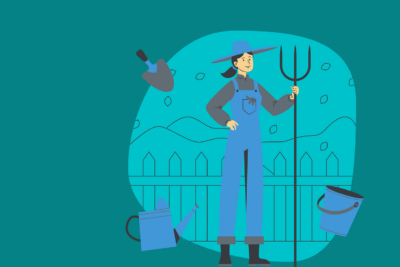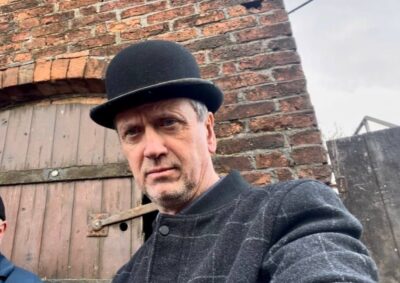Under the Udder – my conventional dairy farm milking experience
In this Article...
A PFFA volunteer tells us about her time milking the cows at a dairy farm. Do you have a story to share? Send it to us at info@the-pffa.org
Several years ago I was walking past the postcard ads board in my local village stationer’s shop when I was particularly struck by a photograph of a beautiful cow’s face looking out at me with big eyes and, on the card, the words ‘Milking Staff Wanted – no experience necessary’. I had some room in my life for an adventure but I had never worked with animals before. Who wouldn’t be tempted I thought?
A couple of hours and a phone call later and I was standing in a large barn face to face with a tall middle-aged slightly defensive farmer who peered at me (small blond female) quizically and asked ‘What are YOU doing here?!’ I reassured him that I had at this stage only come up to see if I could help and what would be involved. He replied ‘ I’ll tell you what’s involved – getting weed on, getting pooed on and getting kicked!’ which was accompanied by a forward lean and a firm Paddington stare. I returned the eye contact with care, nodded and said I’d like to be shown around please. Despite the frosty reception, he was so desperate for help that he took me on.
That was the beginning of an 18-month experience which was more rewarding and insightful than perhaps any other job I had previously undertaken.
The dairy farm had approximately 100 Ayrshire dairy cattle (brown and white) which were milked with hanging suction machinery twice daily and the milk was sold and transported via a farming co-operative to shops in London. The farmer and I struck up an operating friendship whereby we charged up and down the narrow ’pit’ milking and at the same time discussing the latest interesting news items, past experiences, current life concerns and ultimately, after much scepticism he even conceded that my use of reiki energy on udders to calm down ‘grumpy old cows’ might actually have made a difference! Health and Safety learning was real time – the manual was probably buried under a hay bale somewhere – but sufficient nonetheless. At the time, the team comprised the farmer, his brother for cover and 2 part timers, so pretty skeleton in fact.
So what did I learn?
There were daily potential risks such as occasional stampeding or herd disturbances (I learned evasion techniques), heavy animal sizes (I wore steel cap boots), clunky machinery swinging at head height without much warning (I wore a hard hat) and navigating past the guard dog style farm geese on arrival (I wore long boots and usually cruised along behind the farmer himself for protection!). I was advised never to let a cow lick my arms as their tongues are like the harshest version of sandpaper. In addition, risks to contamination of the milk where some cows had infections which had to be promptly identified and cows labelled/segregated accordingly. Daily hygiene procedures before and after milking involved scrubbing down the parlour and cleaning and disinfecting all the equipment very thoroughly.
The farmer also had to comply with regulations, although I was personally only aware of the unannounced milk safety board hygiene and animal welfare audits as well as the vet’s regular reviews of the herd. I was interested to learn that organic dairy milk wasn’t actually 100% organic but there were stringent controls which added to cost/time and made it unviable for this farmer.
I also noted that there were no days off for dairy farmers!
I was told how the unpredictability of weather and the quality of the grass could make a huge difference to production. I never knew that cows disliked the taste of grass at certain lengths so wouldn’t eat much which led to less milk! Other problems the farmer faced were the difficulty recruiting reliable ‘permanent’ staff that would stay for any length of time (it’s jolly hard work) and boy would that help – it’s hard to have any life of your own as a dairy farmer. To add insult to injury, the farmers were faced with supermarket price pressures which made contracting direct totally unprofitable.
I witnessed regularly the relationship between farmer and herd – he knew all their names, was genuinely moved when they died, had a language that the herd understood, tried to save them himself wherever he could (using the tractor bucket to raise up those who fell, administering injections to treat illnesses, assisting cows in labour ). I quickly became aware that cows are intelligent creatures contrary to common belief and they definitely have feelings for their young – I have heard them ‘cry’ when unable to access their calf in another area of the barn. In fact where calves are actually removed at some dairy farms after bonding is well underway, the mothers cry for days afterwards which is painful to listen to.
I felt that the cows were in fact very generous. They were all contained in the barn for winter months, the mothers were parted from their calves after 24 hours (which was to avoid too great an attachment developing as the milk was ultimately destined for human consumers), they were milked twice daily 365 days per year (although milking of course gave them some relief too). This breed were generally a good natured community.
I enjoyed working with the dairy herd and the farmer himself, but could I do it for my daily job? I don’t think I have the stamina for incessant early starts, relentless essential routine, the money worries and monitoring pressures, the demand for complete dedication and the lack of time for any personal life. If anything would coax me back it would be a desire to assist the farmer with all the challenges he faced, the smell of sweet hay, those beautiful animals, the early winter ink-black morning skies pinpricked with stars and the breathtaking view of the sunrise across the fields from the barn. I’d never say never! And dairy farmers are amazing.



